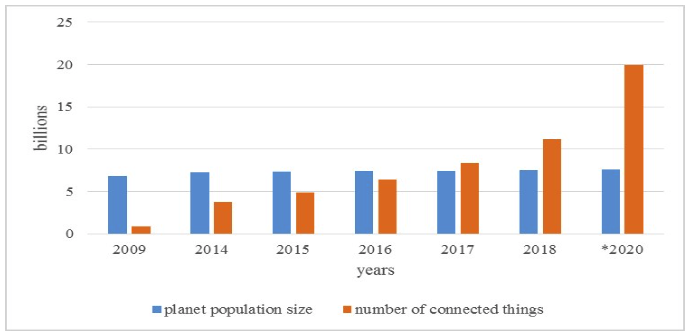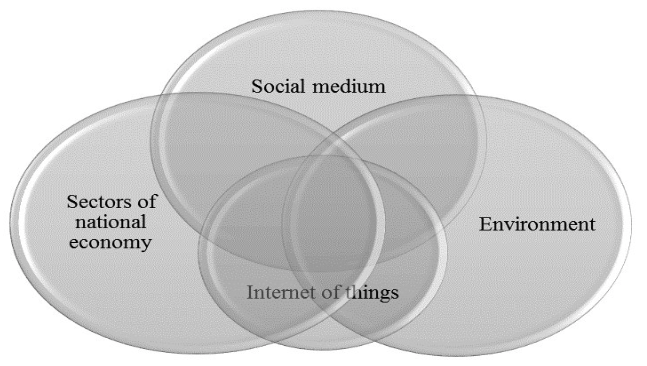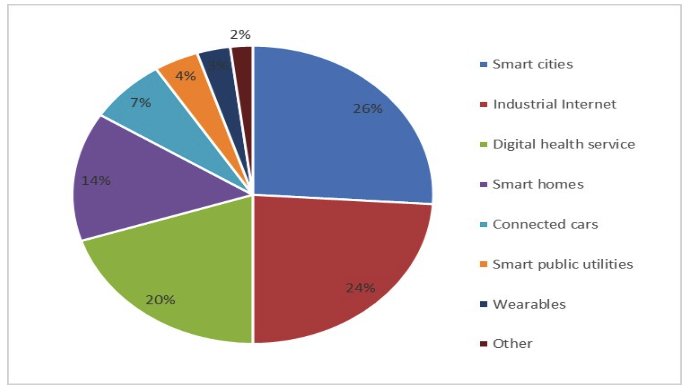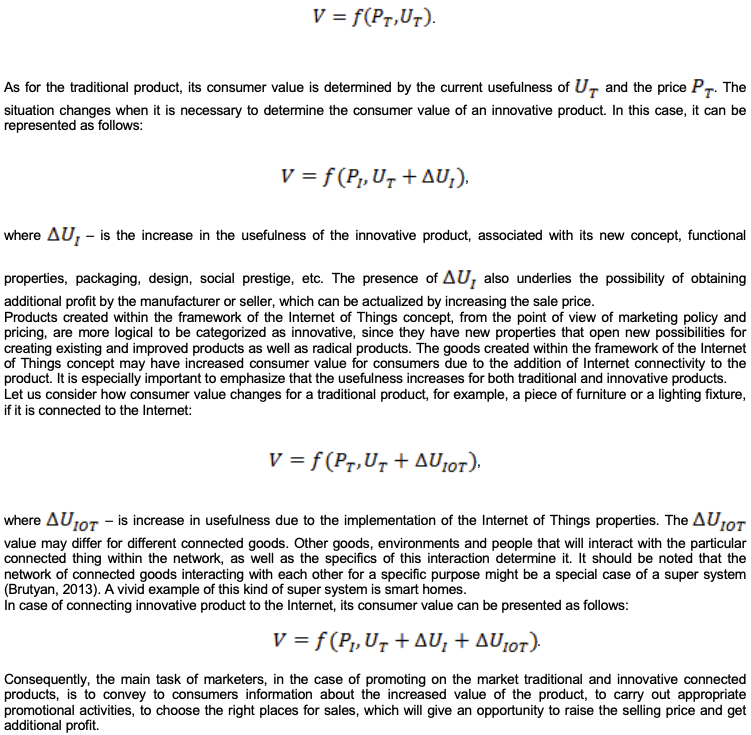

Vol. 40 (Issue 40) Year 2019. Page 25
BRUTYAN, Murad M. 1
Received: 24/07/2019 • Approved: 11/11/2019 • Published 18/11/2019
ABSTRACT: The purpose of the work was to study the marketing features of promotion products, produced within the framework of the Internet of Things concept. The main result of the research is the identification and substantiation of additional consumer value of goods connected to the Internet. Practical application of the developed in the article theoretical provisions consists in the possibility of improving the marketing activity related to the sale of goods connected to the Internet and obtaining additional profits. |
RESUMEN: El objetivo del trabajo fue estudiar las características de marketing de los productos de promoción, producidos en el marco del concepto de Internet de las cosas. El principal resultado de la investigación es la identificación y justificación del valor adicional para el consumidor de los bienes conectados a Internet. La aplicación práctica de las disposiciones teóricas desarrolladas en el artículo consiste en la posibilidad de mejorar la actividad de marketing relacionada con la venta de bienes conectados a Internet y obtener beneficios adicionales. |
In recent times, the concept of Internet of Things is becoming very popular. The Internet of Things can be described as a new wave (the third one in a row), which is taking place in the society over the past 30 years of the information revolution. The first wave was associated with the development of fixed Internet in the 1990s, which connected about 1 billion users. The second wave was observed in the 2000s, and it was associated with the development and widespread use of mobile devices, which connected another 2 billion users. These two waves marked the emergence of online advertising, various mobile applications, online marketing, etc.
According to some projections, by 2025 the number of connected to the Internet of Things objects will show exponential growth and exceed 7 trillion, that is, more than 1000 connected things will fall upon one person (Borgia, 2014). The emergence of a huge number of interconnected facilities – the Internet of Things, by its significance and effect can challenge such former great technological advances as printing press, steam engine, and electricity. Moreover, unlike over past industrial revolutions, this is happening literally before our eyes. The economic effect caused by the development of the Internet of Things technology will be felt by the whole world: both rich and poor countries. According to estimates made by the McKinsey Global Institute, the development of Internet of Things technology has significant potential in developing countries (Mulani & Pingle, 2016). The Internet of Things is quite capable of becoming a kind of catalyst for the fourth industrial revolution. This new state in the scientific literature is referred to as the special term Industry 4.0 or, more simply, the Industrial Internet (Vermesan & Friess, 2014).
The reality is that the Internet of Things opens up virtually unlimited new opportunities and carries a huge number of types of connections between different objects, many of which cannot be understood beforehand and some of them cannot imagine even the best minds in the world. It is not surprising that the Internet of Things is very popular topic at the present time. Of course, it opens up new positive opportunities, but also is fraught with certain risks, threats, and challenges that cannot be ignored. The security and protection of the involved stakeholders’ personal data can be called one of the most important problems (Weber, 2010).
The development and proliferation of the Internet of Things technology will have a huge impact on the economy, forcing many companies in various industries to restructure their existing business models and business strategies, as well as develop and implement new ones. In addition, the efficiency of the enterprises themselves can significantly increase, along with the increase of involvement of employees and consumers in the process of creating products and providing services (Christensen et al., 2017). Marketing methods of promotion product created within the framework of the Internet of Things concept, as well as methods of conducting marketing research and interaction with consumers will undergo major changes. It is necessary to realize clearly specific practical applications of the Internet of Things concept in different sectors of the national economy assess the possible expected effect on the society and also establish what may be new benefits of the product created within the Internet of Things concept that can be conveyed to the consumer through advanced marketing activity.
The work was performed using general theoretical methods of scientific search. In the course of the study, the following methods were used: systemic and logical approach, generalizations, induction, deduction, analysis, synthesis, and mathematical modeling. The information and methodological base of the research were scientific articles and reports published in open press and in the Internet, which were dedicated to current problems of the development of the Internet of Things technology.
According to the World Bank, a significant event happened between 2016 and 2017 – the number of objects connected to the Internet of Things exceeded the population of the Earth (Figure 1) (Market Pulse Report, 2017).
Figure 1
The ratio of the population of the planet and
the number of things connected to the Internet

(Source: Market Pulse Report, 2017)
Currently, there is universal informatization in the world, which covers all public spheres and sectors of the economy (Zanella, Bui & Castellani, 2014). The growth rates of information and data are rapidly increasing. With the development of the Internet of Things, this process will merely intensify (Bondarik & Kucheryavy, 2013). The virtual and digital worlds are gradually intertwined with the real world, becoming like an augmented reality of the physical world. In this regard, the Internet of Things, expectedly, will find practical application in virtually all sectors of the economy and in some way will become a link between social medium, sectors of national economy and the environment (Figure 2) (Yuh-Shyan & Chih-Shun, 2011).
Figure 2
The main areas of the Internet of
Things technology practical application

(Source: Yuh-Shyan & Chih-Shun, 2011)
Let us give some explanations to Figure 2. The use of Internet of Things technology in the sectors of national economy may be associated with activities aimed at the production of means of production and consumer goods, extraction of natural resources and their further processing, provision of certain services to citizens as well as financial and trade transactions between various companies, organizations and other business units. The oil and gas sector, the aerospace industry, the automotive industry, logistics, services sector, insurance, banking, health care, education, housing and utilities, transport, agriculture and animal husbandry, etc., can serve as illustrative examples. With respect to the environment, the Internet of Things is intended to be used as measures of protection, monitoring and lean development of all types of natural resources and maintaining a sustainable ecosystem. Here we can highlight the following areas: waste processing (recycling), air cleanliness monitoring, noise level monitoring, water resources management, energy management, etc. Finally, for the needs of society, the Internet of Things can be used as a system of measures and initiatives aimed at the development of cities, bringing together different communities, and improving the safety and quality of people’s life. Here, the main directions are as follows: emergency services (police, fire brigades, etc.), protection from natural disasters and emergencies, media and entertainment, monitoring large crowds, creation of smart cities, intelligent buildings, monitoring infrastructure, provision of public services to citizens, etc. Moreover, the new value provided by the Internet of Things may consist either in the improvement of existing products and services, and in the provision of new products and services.
Events related to the Internet of Things proliferation are actively taking place all over the world through numerous initiatives that are underway by the medium of industry, scientific communities, and government bodies at various levels, while creating special organizations, alliances, and blocks (Schwab, 2018).
The real volume of the Internet of Things global market in 2016 amounted to 157 billion dollars. The following three areas were dominated in the structure of this market: smart cities, Industrial Internet and digital healthcare (Market Pulse Report, 2017). More information about the structure of the Internet of Things market can be found in Figure 3 (Market Pulse Report, 2017).
Figure 3
The Internet of Things global
market structure in 2016

(Source: Market Pulse Report, 2017)
The USA, China, and Japan have the largest market shares in the segment of Internet of Things among all countries. By 2025, they will account for half of this market. The shares of other countries actively developing the Internet of Things are noticeably leaner. For example, the current UK share in the Internet of Things global market is only 2%.
Today it is obvious that the development of the Internet of Things is already having a noticeable impact on the business. In addition, modern trends are clearly aimed at further strengthening this tendency. The Internet of Things opens up new business opportunities for many firms, both representatives of well-known world-renowned brands, and newbies, taking only the first steps towards conquering markets. In the words of Nobel laureate D. Stiglitz, the Internet of Things will be the technology that will significantly increase the size of total “economic pie”, which means that some successful companies will actually be able to increase their income and market capitalization. In addition to the benefits associated directly with the sale of Internet-connected products and the provision of high-tech services, the Internet of Things will also bring distinct advantages to various areas of business processes, which will also improve the efficiency (Rose, 2017). These advantages include better asset management, improved product life cycle management, better cooperation and interaction between businesses and consumers, improved marketing, etc. It is worth noting that marketing and some of its methods, goals and objectives, ways of conducting research and communicating the consumers’ valuableness of the product created within the framework of the Internet of Things concept may change significantly in the near future. Therefore, it is necessary to understand clearly how the marketing activity can change at the forefront of the fourth industrial revolution [Yanenko & Yanenko, 2014). However, in order to fully realize the enormous potential of the Internet of Things technology, companies must be prepared to face the risks that they will inevitably encounter in the future. In this regard, the insurance industry is becoming more important (Sundmaeker et al., 2010).
Many companies that use the Internet of Things technology have already noted an increase in sales efficiency and an improved vision of the customers. About 40% of these companies believe that the Internet of Things will help them capture new markets (Hewlett Packard Report, 2016). Because the Internet of Things may soon become an integral part of the marketing activity of any company, their managers and marketing specialists should understand in advance the opportunities and advantages that open up before them. In addition, it is necessary to clearly understand what may be marketing advantages of products created within the framework of the Internet of Things concept compared with traditional products. This understanding can make it possible to reap additional profits from the sale of innovative products connected to the Internet.
Let us try to understand what may constitute the additional consumer value of the connected product and how new technologies of the Internet of Things may affect marketing activities and marketing research. In general, consumer value is the ability of a product to satisfy certain needs based on its physical and material properties. The main criterion for the seller in the sale of goods is making profit, so he is interested in maximizing the consumer value of goods and reducing costs. The final price of a product determines its consumer value, if it can be compared with the goods of other product groups. Consumer value of products for the consumer is determined by the ratio of the benefits he receives when buying a product and the cost of purchase. The task of marketing in this case is to convey to consumers the consumer value of the product, to convince them of its compliance with the established price.
As far as is known, the consumer value of a product is a function of its price and the benefits gained, the usefulness (Shchegolev, 2010):

Traditionally, there are two main marketing strategies used to sell various types of products: traditional and innovative. The traditional strategy, as a rule, is used to facilitate the promotion of already existing goods or goods with a small degree of novelty. The innovative strategy is needed when the introduced to the market product either has a significant degree of novelty, or radical consumer properties. Often this is the so-called subversive innovation. When promoting the majority of types of the connected to the Internet goods, you should adhere to innovative marketing strategy. Traditional marketing strategy can be recommended in some cases – when connected to the Internet goods are simple and low-tech products. However in this case, as was shown earlier, marketers need to use the opportunity to derive profit due to the increased consumer value.
In opinion of half of the world’s leading marketers, the proliferation of Internet of Things technologies will have a tremendous impact on the organization and conduct of marketing activity by 2020 (Gartner Report, 2017). Figuratively speaking, the development of Internet of Things will change the entire marketing landscape – the ways of interacting with consumers, making them special offers, collecting information, etc. The Internet of Things technology will provide programmers and advertisers with an exponentially greater number of ways to collect information about a person’s habits, his preferences, and most importantly, to understand their meaning. Currently, the marketing usefulness of the Internet of Things technology is not fully understood and leaves fertile ground for further research in this area. According to an IBM study, only 22% of consumers surveyed said that the average trading company understood what they wanted and only 21% thought that the marketing offers they received from medium-sized trading companies were mostly relevant. Therefore, marketers face a clear challenge in finding a suitable approach to attract potential customers and maintain the loyalty of the existing customers (IBM and Econsultancy Study, 2015).
Marketers should focus on the fact that consumers in the future would receive more personalized offers of specific products and services formed on the basis of more detailed information collected about them. For example, information about where they are at the moment, what they are doing, whether they are alone or in the office and so on. To stay afloat, the sellers must provide more advanced products and services through a careful study of consumer behavior. They should also monitor constantly the need for new products and services. In this regard, wearable devices have great potential to significantly help marketers better understand their target group. Internet-connected things and sensors are becoming a real factor in attracting customers and collecting data (EY Report, 2016). Since over time more objects will be connected to the Internet, the number of interactions between marketers and consumers will gradually increase. Moreover, the geography of such interactions will also expand. Consumers will be able to receive personal offers from marketers not only in the shop, but also at home through connected home appliances or while on the street through wearable devices. In addition, marketers will be able to tailor specifically and improve products at the right time and in the right place based on feedback from customers that will increase and even maximize the efficiency and quality of service. The ongoing marketing activities in the future will increasingly meet the needs and desires of customers. The important point is that consumers can be involved in the process of developing a new product through various connected devices. In this case, marketers can not only help developers create new products that fully meet the needs of their customers, but also more easily attract potential customers, knowing their specific consumer preferences (Sycheva & Yakushin, 2016).
Traditional understanding of marketing and its essence will undoubtedly remain the same with the development of Internet of Things technology, but external changes will have a significant corrective impact. Both the whole business and its various directions will expectedly undergo essential changes with the development of the third wave of the Internet (Case, 2017). Marketing also will not stand aside the emerging technological trend. In the age of Industrial Internet, marketing can be described as a specific type of activity, which, firstly, is connected with various aspects of selling a new product created within the framework of the Internet of Things concept. Secondly, most of the interaction with the consumer obtaining the necessary market information is not carried out based on personal communication, polls, focus groups, consumer panels, etc.; but using various Internet-connected things.
It is becoming more and more difficult for companies to stay afloat, because competition in the markets is becoming increasingly fierce and various changes occur almost constantly. As it is known, the market seeks to remove everyone from the entrepreneurial role except those who are able to predict the future demand of consumers better than others (Knight, 2014; Kirtsner, 2010). The Internet of Things technology can give this opportunity to those entrepreneurs who will be able to carry out targeted marketing research with their help and on their basis predict future consumer demand.
Thus, the development of Internet of Things technologies can have a strong impact on marketing activities, manifesting itself in various aspects: marketing strategies, pricing, product promotion, advertising, customer interaction, market research, etc.
There is no doubt that in years ahead the development of the Internet of Things technology will show itself in various initiatives, applications, and business areas and will introduce significant changes in people’s everyday social life. This will be especially noticeable in large and innovative cities. The Internet of Things is a developing technology of the third wave of the Internet, a forerunner of the fourth industrial revolution, which is not yet mature enough to allow a comprehensive, multi-factor analysis. In order to take full advantages of the Internet of Things, it is necessary to understand clearly all possible risks that may be associated with it. Individual countries and a number of companies have already made a bet on the development of the Internet of Things allocating significant amounts of money for these purposes. The main goals that they pursue are promoting economic growth, creating new markets, pursuing profits, strengthening their technological leadership, and achieving competitive strategic advantages.
For business, the Internet of Things will also prove to be a key technology, the competent use of which can help achieve its business goals. The basis of the new world order in business is that reputational capital is gained with great difficulty and can be easily lost, as the world becomes more transparent and various processes and interactions occur at a rapid rate. The Internet of Things will just strengthen these trends. Therefore, in a new environment, a company can no longer risk its reputation and tolerate poor product quality, since the cost of a mistake increases greatly. Marketing in the new conditions of business development becomes its key component allowing it to stay afloat. Companies should strive to utilize the Internet of Things technology fully in their marketing activity in order to interact better with consumers, study their consumer behavior and preferences, improve service quality, and create a more pleasant image of the company.
An important aspect is that in the case of selling Internet-connected things, companies should try to get maximum benefit for themselves, striving to convey to the consumer information about the increased consumer value of such things. This opens up opportunities for extra profit, in addition to the profits from the sale of traditional and innovative products.
Bondarik, V. & Kucheryavy, A. (2013). Forecasting the development of the Internet of Things on the planning horizon until 2030. MIPT works. No.3. V.5, 92-96.
Borgia, E. (2014). The Internet of Things vision: Key features, applications and open issues. Computer Communications. No.54, 1-31.
Brutyan, M. M. (2013). From technology, through a system of technologies to a supersystem. Innovations and investments. No.1, 154-160.
Case, S. (2017). The third wave of the Internet. M.: Eksmo, 189.
Christensen, K., Hall, T., Dillon, K. & Duncan, D. (2017). The Law of Successful Innovations: Why a customer “hires” your product and how knowledge of this helps new developments. Moscow: Publishing House Alpina Publisher, 268.
EY Report, Internet of Things: Human-machine interactions that unlick possibilities. 2016. [Electronic Resource]. URL: https://www.ey.com/Publication/vwLUAssets/ey-m-e-internet-of-things/$FILE/ey-m-e-internet-of-things.pdf.
Gartner Report, Leading the IoT: Gartner Insights on How to Lead in a Connected World. 2017. [Electronic Resource]. URL: https://www.gartner.com/imagesrv/books/iot/iotEbook_digital.pdf.
Hewlett Packard Enterprise Report, The Internet of Things: Today and Tomorrow. 2016. [Electronic Resource]. URL: http://chiefit.me/wp-content/uploads/2017/03/HPE-Aruba_IoT_Research_Report.pdf.
IBM and Econsultancy Study, 4 Out of 5 Consumers Declare Brands Don’t Know Them As An Individual. 2015. [Electronic Resource]. URL: https://www-03.ibm.com/press/us/en/pressrelease/46454.wss#resource.
Kirtsner, I. (2010). Competition and entrepreneurship. Chelyabinsk: Social medium, 272.
Knight, E. (2014). The Art of Corporate Endurance. Harvard Business Review. [Electronic Resource]. URL: https://hbr.org/2014/04/the-art-of-corporate-endurance.
Market Pulse Report, Internet of Things (IoT). 2017. [Electronic Resource]. URL: https://growthenabler.com/flipbook/pdf/IOT%20Report.pdf.
Mulani, T. & Pingle, S. (2016). Internet of Things. International Research Journal of Multidisciplinary Studies and SPPP`s. No.1, 1-4.
Rose, D. (2017). The Future of Things: How fairy tale and fantasy become reality. M.: Alpina non-fiction, 344.
Schwab, K. (2018). The Fourth Industrial Revolution. M.: Eksmo, 288 p.
Shchegolev, V.V. (2010). Methods of the industrial production customer value assessment. St. Petersburg State Polytechnical University Journal. No.3, 197-201.
Sundmaeker, H., Guillemin, P., Friess, P. & Woelffle, S. (2010). Vision and Challenges for Realising the Internet of Things. Luxembourg: Publications Office of the European Union, 229.
Sycheva, O & Yakushin V. (2016). Internet of Things as a driving force of marketing. Russian Journal of Retail Management. No.4, 341-348.
Vermesan, O. & Friess, P. (2014). Internet of Things – From Research and Innovation to Market Development. Aalborg: River Publishers, 355.
Weber, R. (2010). Internet of Things – New security and privacy challenges. Computer Law & Security Review. No.26, 23-30.
Yanenko, M. B. & Yanenko, M. E. (2014). Interaction marketing in the information economy: problems and prospects for the development of the Internet of Things // Bulletin of Novgorod State University. No.82, 77-81.
Yuh-Shyan, C., & Chih-Shun, H. (2011). Green Internet of Things. [Electronic Resource]. URL: http://docplayer.net/13192901-Green-internet-of-things-iot.html.
Zanella, A., Bui, N., & Castellani, A. (2014), Internet of Things for Smart Cities. IEEE Internet of Things Journal. No.1. Vol.1, 22-32.
1. Specialist, Central Aerohydrodynamic Institute named after Prof. N.E. Zhukovsky, Moscow Region, Zhukovsky, Zhukovsky str. 1, btm23@mail.ru